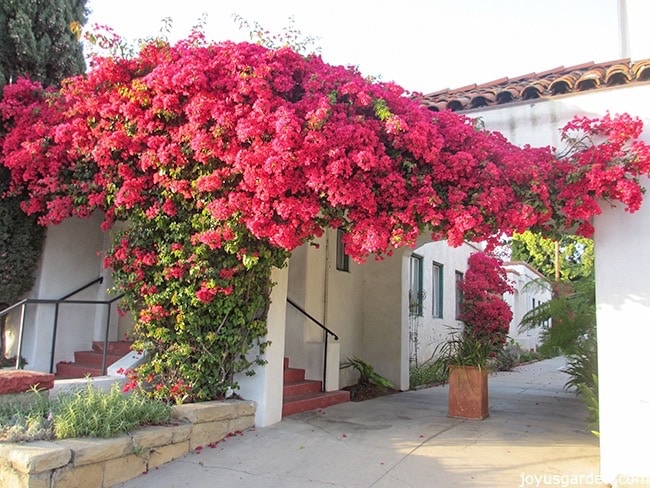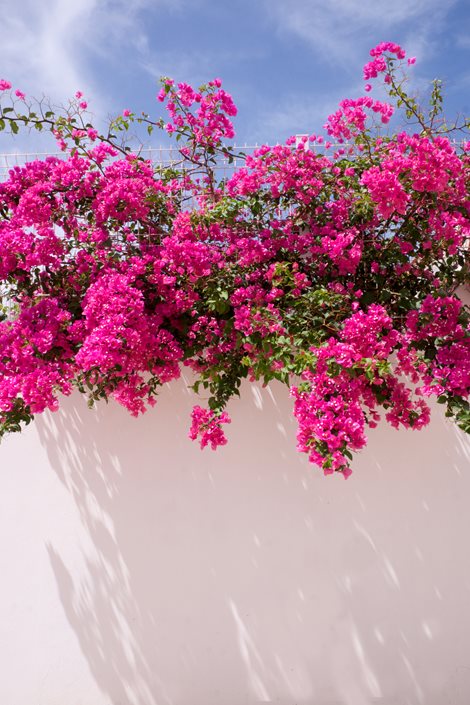
Because bougainvilleas are short-day plants, it is best to place them in full sun but make sure they receive no more than 12 hours of direct sunlight every day to encourage flowering. Once a week watering of potted bougainvilleas creates the ideal moisture and drought stress balance to promote more blossoms.
Brazilian bougainvilleas are native, and shorter days encourage blossoming by signaling to the plant that the time is suitable for it to show off its blossoms in accordance with the seasonal conditions.
One of the most important elements influencing the growth of bougainvillea blossoms is shorter days. Read on to discover the 7 strategies to get more flowers and get them to stay on show longer.
Table of Contents
1. Bougainvillea Blooms More with Shorter Day Lengths
The bougainvillea are somewhat unique! Even though they need daylight, shorter days will cause them to bloom more.
This odd trait is a product of adaptations made for tropical climates where the bougainvillea knows when to bloom since the days are shorter than the nights during the dry season.
Therefore, it is important to reproduce these circumstances. For bougainvillea to bloom, at least 12 consecutive hours of darkness are required.
Therefore, individuals who reside in northerly latitudes may have a little trouble locating the ideal location for their bougainvillea.
For instance, there can be up to 15 hours of daylight in the UK and up to 16 in New York during the height of the summer.
Make sure there aren’t any artificial lights on at night so that the recommended 12 hours of darkness are maintained.
If you’re very dedicated (like me), you might be able to reproduce the natural conditions for flowering of your bougainvillea by covering it with a cloche, horticultural fleece, or even an umbrella.
Although bougainvillea still needs a lot of direct sunlight to bloom, the amount of sunlight exposure should be limited to just around 12 hours per day.
Fortunately, bougainvillea can bloom all year long in moderate winter climates, such as those in the Mediterranean, but regardless of location, they will bloom more when there are 12 or more hours of darkness each day.
Fun fact: The blossoms on bougainvillea are actually rather tiny and delicate. The huge, vibrant petals are actually bracts, a type of leaf with the specific purpose of luring pollinators to the bloom.
2. Water Less Often for More Flowers
Since they are native to Brazil, bougainvillea thrive in hot, dry climates.
So it’s crucial to avoid watering them too frequently.
Because they can withstand drought, bougainvillea should be cared for differently than your hydrangea and rose arrangements and more like your lavender and Mediterranean herb collection.
Normally, you should thoroughly water your potted bougainvillea once a week, but you should hold off if the soil feels moist to your fingers depth. Before rehydrating the soil, it should only feel as though it is beginning to dry out.
Inducing a stress response in your plant by watering it excessively can eventually result in fewer flowers. Less watering will cause some drought stress and encourage the bougainvillea to bloom more. Given that blossoms represent the plant’s method of reproduction, this is an intriguing survival response on the part of the bougainvillea.
I personally water my potted bougainvillea once a week, and as a result, I get to enjoy this show of blooms.
In most cases, mature bougainvillea vines grown in garden borders do not need to be watered unless they are young plants without a well-established root system or there is an extreme drought.
(It is significant to note that different seasons of the year require varying amounts of watering for bougainvillea. To learn how to water a potted bougainvillea, see my post.
3. Direct Sunlight Promotes Bougainvillea Blooms
For bougainvillea, direct sunlight is essential. As you might expect, they have plenty of this in their home Brazil, so wherever you are, it’s crucial to try to mimic those conditions in your garden.
Plant your bougainvillea where it will receive at least 6 hours a day of direct sunlight. This will guarantee that your bougainvillea receives enough sunlight to encourage a strong bloom display.
It’s a smart idea to plant your bougainvillea in pots so you can relocate them to full light places as the seasons change.
Additionally, if you reside somewhere other than a Mediterranean climate, you can transfer these pots indoors for the winter. The plant will benefit from this protection against the cold and probable frosts.
(Bougainvillea frequently lose their leaves in the winter if they are not in an ideal climate; however, with proper care, the leaves can regenerate in the spring; check my post on bougainvillea losing their leaves for more information on how to rescue your bougainvillea.)
Remember that enhanced blooms depend on both the strength of the sun and the shorter day length.
4. Warm Temperatures Increase Flowering

Ideal nighttime temperatures should be in the range of 65°F (18°C). However, bougainvilleas can withstand milder (but not freezing!) nighttime temperatures and still put on a showy display of flowers because to their hardiness and adaptability.
Put your bougainvillea in a protected area to protect it from the cold winds.
Plant stress might occur if the nights are excessively chilly. Because bougainvilleas cannot withstand extremely cold temperatures, it is vital to plant them in pots and bring them indoors during the winter in colder locations.
To ensure that your pot receives both inside warmth and sunlight for the best blooms, place it in a sunny window area.
5. Use Less Fertilizer for More Flowers
If you fertilize your bougainvillea too much, the flowers will be sacrificed in favor of lush, green foliage.
Your bougainvillea should need little to no fertilizer if they are well-established and placed in borders. They probably prosper in that location because their soil is well-drained rather than fertile (see point 6 on drainage).
To guarantee your bougainvillea get the right nutrients for flowering and not too much nitrogen if they are in pots, use some half strength all-purpose fertilizer (the chemical responsible for that lush green foliage). Once the risk of cold weather has passed, apply the fertilizer in the early spring. Keep in mind that bougainvillea are not cold-resistant!
When the days start to become shorter, I personally have had wonderful success stopping fertilizer use because the’stress’ of fewer nutrients being available actually encourages flowering.
The bougainvillea can be influenced to prioritize reproduction—by flowering—rather than growth on its leaves, roots, and vines in the same manner as dry stress can.
6. Well Draining Soil Increases Blooms
As previously mentioned, bougainvillea have evolved to thrive in soil with good drainage. Because the roots could decay, they cannot tolerate soggy, overwatered soil. Make sure your bougainvillea has sufficient drainage to promote blooming.
To imitate the well-draining soil conditions the bougainvillea has in its native Brazil, ensure your soil has sufficient drainage by adding horticulture grit.
To guarantee the ideal balance of soil moisture for the bougainvillea to display blossoms, use the same formula as when making a potting mix for Mediterranean herbs: one third horticultural grit and two thirds peat free compost.
If you are planting in pots, check that the pots’ bases have drainage holes to effectively let surplus water evaporate after watering. Bougainvillea may therefore thrive in pots since you have greater control over the drainage than you do with garden borders.
7. Pruning Bougainvillea for More Flowers
To increase your bougainvillea flower show, prune your bougainvillea in late winter or early spring before spring growth starts growing. Bougainvillea blooms are displayed on new seasons growth rather than old wood.
It’s always advised to strategically cut bougainvilleas because they can become lanky and produce fewer flowers if you don’t.
Light pruning is excellent for promoting flowering and can help you retain the bougainvillea in the desired shape on your trellis or support structure. Heavy pruning can divert too much energy to the growth of new branches and vines. Light pruning is best for promoting flowering.
Watch this instructive YouTube video to learn how to prune your bougainvillea to get more flowers:
(Read my post on how to care for bougainvillea in pots for further advice and the industry’s best practices.)
